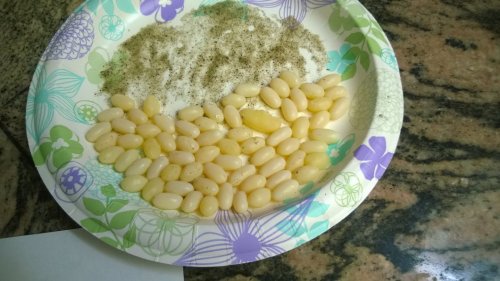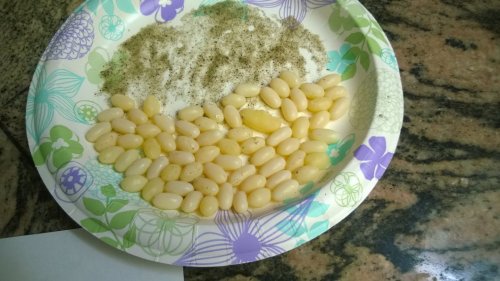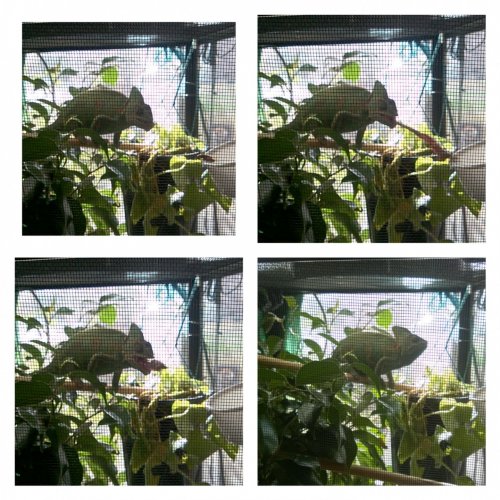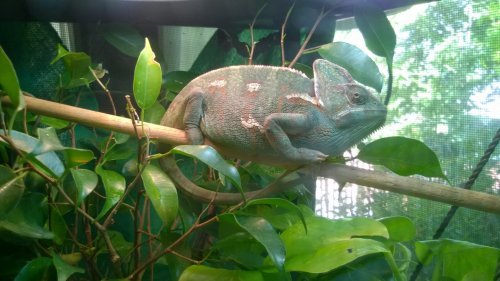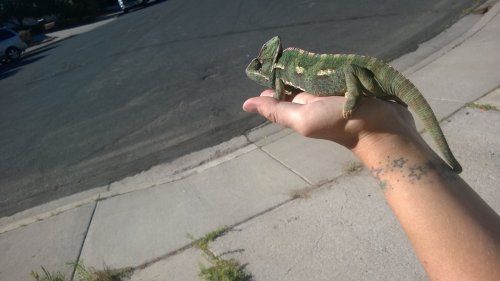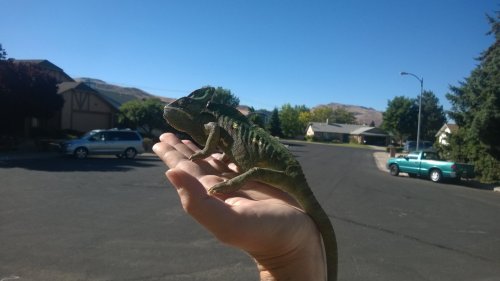Navigation
Install the app
How to install the app on iOS
Follow along with the video below to see how to install our site as a web app on your home screen.
Note: This feature may not be available in some browsers.
More options
You are using an out of date browser. It may not display this or other websites correctly.
You should upgrade or use an alternative browser.
You should upgrade or use an alternative browser.
stella laid 70 eggs?
- Thread starter miranick
- Start date
miranick
New Member
Chameleon Info:
•Your Chameleon - 1.5yo-ish female veiled chameleon, we've had her about 14 mos
•Handling - she is anti-social, but eats from my hand just fine.
•Feeding - What are you feeding your cham? She gets 8-10 well-fed crickets daily, 2-3 waxworms twice a week, she refuses pretty much everything else we've tried. Bugs get fruit, all kinds of flukers crap, lettuces
•Supplements - reptical no/d3 daily, flukers calcium with d3 every other Saturday and repcal herptivite on the Saturdays that she doesn't get w/d3
•Watering - climist Darwin 50- it comes on from 7a-7p every three hours for 45sec. She drinks off everything but prefers to be misted herself and lick off her cask
•Fecal Description - brown and moist, largeish, with hard white at end. Not tested for parasites.
•History - Stella is pretty ..uneventful except that she hisses at anyone who doesn't live here and gets up to here cage.
Cage Info:
•Cage Type - zoo-med full screen 3'cage.
•Lighting - 60 blue and tube in double lamp. Comes on at 7a turns off at 7p
•Temperature - 78-80 at top and low 60s at bottom, I have sensors
•Humidity - our house iss pretty humid, we have a humidifier we run constantly to prevent "Nevada nose" for our kids.
•Plants - Are you using live plants? If so, what kind? Live plants, mini ficus, umbrella plant and....pothos. There are also plants surrounding her cage as a cat-barrier.
•Placement - Where is your cage located? Is it near any fans, air vents, or high traffic areas? At what height is the top of the cage relative to your room floor? Stellas cage is in a window in the living room, it is pretty high traffic but she doesn't seem to care. She sits right up front watching everything. One side is covered because she dislikes the tv so its blocked from view. There is a vent beneath the craft dresser she's on. Our house is kept at 68*. Her perch is about 6' high, top of cage probably 6..5'
•Location - Where are you geographically located? We are in northern Nevada, sparks, Washoe valley.
Current Problem - The current problem you are concerned about.
Stella has not laid eggs before and for her first go she laid 70. This seems very high. What can I do to lower the qty of eggs laid? I don't want her to be short lived from egg overproduction.
•Your Chameleon - 1.5yo-ish female veiled chameleon, we've had her about 14 mos
•Handling - she is anti-social, but eats from my hand just fine.
•Feeding - What are you feeding your cham? She gets 8-10 well-fed crickets daily, 2-3 waxworms twice a week, she refuses pretty much everything else we've tried. Bugs get fruit, all kinds of flukers crap, lettuces
•Supplements - reptical no/d3 daily, flukers calcium with d3 every other Saturday and repcal herptivite on the Saturdays that she doesn't get w/d3
•Watering - climist Darwin 50- it comes on from 7a-7p every three hours for 45sec. She drinks off everything but prefers to be misted herself and lick off her cask
•Fecal Description - brown and moist, largeish, with hard white at end. Not tested for parasites.
•History - Stella is pretty ..uneventful except that she hisses at anyone who doesn't live here and gets up to here cage.
Cage Info:
•Cage Type - zoo-med full screen 3'cage.
•Lighting - 60 blue and tube in double lamp. Comes on at 7a turns off at 7p
•Temperature - 78-80 at top and low 60s at bottom, I have sensors
•Humidity - our house iss pretty humid, we have a humidifier we run constantly to prevent "Nevada nose" for our kids.
•Plants - Are you using live plants? If so, what kind? Live plants, mini ficus, umbrella plant and....pothos. There are also plants surrounding her cage as a cat-barrier.
•Placement - Where is your cage located? Is it near any fans, air vents, or high traffic areas? At what height is the top of the cage relative to your room floor? Stellas cage is in a window in the living room, it is pretty high traffic but she doesn't seem to care. She sits right up front watching everything. One side is covered because she dislikes the tv so its blocked from view. There is a vent beneath the craft dresser she's on. Our house is kept at 68*. Her perch is about 6' high, top of cage probably 6..5'
•Location - Where are you geographically located? We are in northern Nevada, sparks, Washoe valley.
Current Problem - The current problem you are concerned about.
Stella has not laid eggs before and for her first go she laid 70. This seems very high. What can I do to lower the qty of eggs laid? I don't want her to be short lived from egg overproduction.
Attachments
Virgil1972
Avid Member
That is a lot of eggs. Feeding her less can help reduce clutch size.
guanagator
Avid Member
I feed every other day for adults, keeps the clutch size down some with my panthers. You would be surprised how little they actually need to be healthy. Most chameleons in captivity have some extra weight on them.
jajeanpierre
Chameleon Enthusiast
Is that picture of her before or after she laid eggs? How close to when she laid the eggs?
Feed her really well for a few days until she has recovered and then only feed her every other day or two. Make sure she gets lots of calcium twice a day. Drastically cut back on her food and her temperatures. Reduce her weight and get her really lean. Make sure she has calcium at every feeding. That's a lot of eggs, and although they aren't very well calcified, they still took a lot of calcium from her and she needs to replenish it as quickly as possible.
I have a problem overfeeding my chameleons, and it is not an easy thing for me to correct but I have to or my females will live very short lives. I have asked a much more chameleon keeper to tell me exactly how much to feed.
Feed her really well for a few days until she has recovered and then only feed her every other day or two. Make sure she gets lots of calcium twice a day. Drastically cut back on her food and her temperatures. Reduce her weight and get her really lean. Make sure she has calcium at every feeding. That's a lot of eggs, and although they aren't very well calcified, they still took a lot of calcium from her and she needs to replenish it as quickly as possible.
I have a problem overfeeding my chameleons, and it is not an easy thing for me to correct but I have to or my females will live very short lives. I have asked a much more chameleon keeper to tell me exactly how much to feed.
jajeanpierre
Chameleon Enthusiast
Excellent, thank you for your answers! The picture of her is from march 19. I just took her pic now and she's like this...I fed her 10 calcium dusted crickets after I noticed her resting for a few on her perch.
She's definitely not skinny. You want her skinny. It will be harder on you than it will be on her. She also looks like she has a bit of a gular edema (retained fluid around her throat area). I suspect it is related to her being gravid. If she goes back to her normal healthy self, start cutting her food right back but make sure she gets lots of nutrition. Give her the best feeders that are raised on really healthy food. WIld caught feeders are healthier than anything you can raise. Gutload them. Stick an hibiscus plant in her cage so she can eat that. Make sure she has lots of calcium and really good lighting. Now it is summer, try to get her out in the real sun. They will bask outside in the morning and late afternoon, not in the middle of the hottest part of the day. You do not want her to lay that many eggs again. You will have to really drop her down hard to stop her production. Don't be afraid to do it.
JGuinan007
Avid Member
My veiled chameleon had 48 eggs her 1s time I was told that was too much and to feed her less and lower her basking temps I did that and her 2nd clutch was 60 eggs so I don't see how any of that reduces clutch size I think Veileds in general are just egg factories and it's just part of their species genetic survival strategy to have large clutches and hope some survive to adulthood to keep the cycle goingThat is a lot of eggs. Feeding her less can help reduce clutch size.
jajeanpierre
Chameleon Enthusiast
My veiled chameleon had 48 eggs her 1s time I was told that was too much and to feed her less and lower her basking temps I did that and her 2nd clutch was 60 eggs so I don't see how any of that reduces clutch size I think Veileds in general are just egg factories and it's just part of their species genetic survival strategy to have large clutches and hope some survive to adulthood to keep the cycle going
Maybe you didn't drop her down low enough in temps or in weight. They tend not come into breeding condition if they are starving. It is a fine line between starving and healthy. I wonder if reducing the number of hours of light would reduce clutch size. Light is used to stimulate ovulation when nature says it is not the right season.
JGuinan007
Avid Member
I'm not reducing her temps or feeders any more than what I have already, a long life of being cold and starving yet having smaller clutches or being comfortable and eating healthy with larger clutches yet living slightly shorter I will go with the later and let her have a better quality of life.Maybe you didn't drop her down low enough in temps or in weight. They tend not come into breeding condition if they are starving. It is a fine line between starving and healthy. I wonder if reducing the number of hours of light would reduce clutch size. Light is used to stimulate ovulation when nature says it is not the right season.
KapitalJ
Avid Member
I'm not reducing her temps or feeders any more than what I have already, a long life of being cold and starving yet having smaller clutches or being comfortable and eating healthy with larger clutches yet living slightly shorter I will go with the later and let her have a better quality of life.
Would you tell your child to eat candy and junk food to be happy rather than be healthy?
JGuinan007
Avid Member
Would you tell your child to eat candy and junk food to be happy rather than be healthy?
It was very unkind to speak of my children DO NOt DO IT AGAIN my children eat all natural organic foods no soda candy only around the holidays and no soda ever they eat well and healthy and my chameleon eats every other day 3 Dubias and 1 super worm with 1-2 horn worms or 2-3 silk worms a week all dusted with calcium, once a month calcium with d3 and once a month multivitamin with d3 when she became gravid/receptive she wouldn't really eat all that much, after she lays I feed her every day 4 dubia 2 horn worms 2 butter worms 2 silk worms til her weight and strength is back up so she is very healthy her fecals have always been good and her vet visits they she is very healthy although my vet admits he knows very little about Chameleons
It was very unkind to speak of my children DO NOt DO IT AGAIN my children eat all natural organic foods no soda candy only around the holidays and no soda ever they eat well and healthy and my chameleon eats every other day 3 Dubias and 1 super worm with 1-2 horn worms or 2-3 silk worms a week all dusted with calcium, once a month calcium with d3 and once a month multivitamin with d3 when she became gravid/receptive she wouldn't really eat all that much, after she lays I feed her every day 4 dubia 2 horn worms 2 butter worms 2 silk worms til her weight and strength is back up so she is very healthy her fecals have always been good and her vet visits they she is very healthy although my vet admits he knows very little about Chameleons
Last edited:
KapitalJ
Avid Member
Exactly my point. You choose for your kids to be healthy.... not just give them what they want.
I am not at all saying you don't take good care of your cham.
My kids arent happy with green beans and salads, but we make them eat it. If it were up to them being "happy" They would eat ice cream and candy for dinner...
I am not at all saying you don't take good care of your cham.
My kids arent happy with green beans and salads, but we make them eat it. If it were up to them being "happy" They would eat ice cream and candy for dinner...
jajeanpierre
Chameleon Enthusiast
I'm not reducing her temps or feeders any more than what I have already, a long life of being cold and starving yet having smaller clutches or being comfortable and eating healthy with larger clutches yet living slightly shorter I will go with the later and let her have a better quality of life.
I don't understand your either/or position.
Unfit, obese, inactive, egg bound females are anything but having a "better quality of life." I'm quite sure they will develop MBD since they will be producing too many eggs for their bodies to be able to calcify. It happens in laying chickens, which are bred to produce many many times more eggs than is "natural." Why wouldn't it happen in female chameleons that are producing two or three times a normal clutch size two or three times more often than they would in the wild all the while being fed a poor diet with poor access to proper light (no artificial light comes anywhere close to the spectrums that the sun produces or the intenstity).
Dystocia in lizards happens in 18% of the lizard populations yet is extremely uncommon in wild populations that were monitored and studied (Mader, Reptile Medicine and Surgery).
Last, reptiles are cold blooded so don't feel "cold" per se and starving animals don't thrive. Your suggestions that an animal destined to die of dystocia is more comfortable throughout its life is a stretch.
miranick
New Member
I appreciate everyone's feedback, and after a few days of calcium crickets/silkworms I'll reduce her food to every other day, always dusted, and I looked and I have the blue glass bulb and the compact fluorescent. I really want her to be healthy, and while I know I'll be always worried, she will be fine. Thank you so much. I'm not planning on ever breeding her (just like any of my other pets). I'll post how many she lays next time.it happens, hopefully with the changes she'll have less and be healthier. Ooo and because she's in a window, I'm going to trim back the foliage around it so I can open the window and let her have real sun. She won't let me take her out of the cage, hasn't ever wanted to be held and the couple times I had to take her out she bee-lined for her basking spot. It's a slow process!
Last edited:
jajeanpierre
Chameleon Enthusiast
I appreciate everyone's feedback, and after a few days of calcium crickets/silkworms I'll reduce her food to every other day, always dusted, and I looked and I have the blue glass bulb and the compact fluorescent. I really want her to be healthy, and while I know I'll be always worried, she will be fine. Thank you so much. I'm not planning on ever breeding her (just like any of my other pets). I'll post how many she lays next time.it happens, hopefully with the changes she'll have less and be healthier. Ooo and because she's in a window, I'm going to trim back the foliage around it so I can open the window and let her have real sun. She won't let me take her out of the cage, hasn't ever wanted to be held and the couple times I had to take her out she bee-lined for her basking spot. It's a slow process!
You can just take her whole cage out. There is more than one way to get them real sun. You understand that UVB will not pass through a glass window, don't you? Be careful that your cage doesn't heat up in the sun either in the window or outside.
Good luck. Keep her cooler. You are trying to get her out of breeding condition and you might have to cut everything back hard since she has already in breeding condition.
miranick
New Member
That's a great idea! I planned to have her window open so the sun would only be coming through the screen, not the glass part. Our temps have been 70s in the morning (7am) and have been Going to the 90s during the day, even evening it's quite hot. Probably morning would be best. Don't want any chameleon bacon!You can just take her whole cage out. There is more than one way to get them real sun. You understand that UVB will not pass through a glass window, don't you? Be careful that your cage doesn't heat up in the sun either in the window or outside.
Good luck. Keep her cooler. You are trying to get her out of breeding condition and you might have to cut everything back hard since she has already in breeding condition.
MeruJack
Avid Member
My 1.5yo veiled laid 70 eggs on her first go! She's never been around a male so I know they're not fertile. What can I do so she doesn't lay so many? Is it bad for her?
Here's a link to the Forum's Veiled Chameleon Care Sheet: https://www.chameleonforums.com/care/caresheets/veiled/
Good luck to you and Stella!
cyberlocc
Chameleon Enthusiast
I'm not reducing her temps or feeders any more than what I have already, a long life of being cold and starving yet having smaller clutches or being comfortable and eating healthy with larger clutches yet living slightly shorter I will go with the later and let her have a better quality of life.
I must say I am not getting this either. You realize that temps are hot and cold depending on the day, and they eat 1 or 2 times a week if they are lucky. In the wild they do not have 4+ clutches a year, if you overfed and overheat they will. That isn't natural for them however.
You are trying to humanize what you think is a better life, and your version goes against the nature of the animal so better, no not by a long shot.
This is not a human, it is a reptile. One that in nature goes weeks without eating. That is there natural behavior, who are you to say you know better than nature?
Similar threads
- Replies
- 5
- Views
- 818
- Replies
- 59
- Views
- 5K

